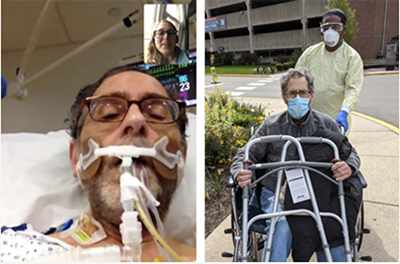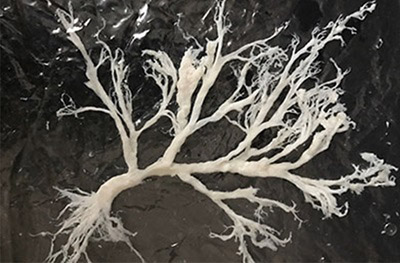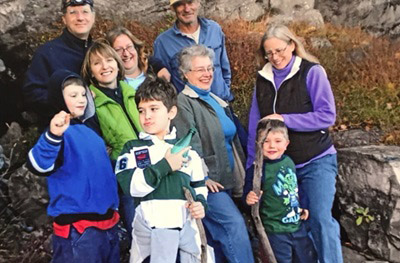Medical Miracles on 34th Street: Perelman School of Medicine
A Close Call with COVID-19 Ends in a Presby Proposal
“Funny” was the word 68-year old Robert Calandra first used when describing the symptoms that would eventually lead to a COVID-19 diagnosis. But soon, “funny” turned to “odd,” which turned to “very, very wrong.” The Ambler resident is a talented writer whose work has appeared in books, magazines, and newspapers, but he never expected that his own life would become the story.
He felt fine while playing ice hockey one day in early March, but by the following day, his temperature began inching up, and he felt increasingly tired and listless. “I actually went into my office and pulled out my will and medical power of attorney, wrote some notes, signed them, and left them prominently on my desk. I just had a feeling that something bad was happening,” he said. “From there, it spiraled.”
At the encouragement of his primary care physician and friend Michael Cirigliano, a Penn Medicine internist, Mr. Calandra visited the drive-through coronavirus testing site in Radnor. But his longtime girlfriend Monica Hamill soon needed to call Dr. Cirigliano again—Mr. Calandra’s temperature had jumped to 102.5 degrees, and he was so weak that he could barely sit up, even with Ms. Hamill’s help. Cautioning Ms. Hamill to stay at home to contain the virus in case she was also infected, Dr. Cirigliano recommended that Mr. Calandra’s daughter, Lindsey Calandra, a nurse practitioner at Children’s Hospital of Philadelphia, go out and purchase a pulse oximeter for her father. If it showed his oxygen level was under 90 percent, they needed to go to the emergency room immediately. Mr. Calandra’s reading was a dangerously low 80 percent.

“I was pretty out of it, but I did tell them that Penn Presby was the only place I wanted to go,” Mr. Calandra said, explaining that he had previously received exceptional care at PPMC when he experienced septic shock. “Monica bundled me into the car, and from there, I remember flashes—parts of the car ride, being helped into a wheelchair, arriving in the isolation room,” he recalled. “My last clear memory is of the doctor telling me I needed to be intubated immediately. And then... I began my magical mystery tour.”
For Ms. Hamill and Lindsey Calandra, the next several days were harrowing. Because they could not visit the hospital due to COVID-19 precautions, Lindsey Calandra established contact with his care team and regularly received a roller coaster of updates. Mr. Calandra was initially described as “very sick,” then seemed to be pulling through, only to suddenly become unstable again.
But the experience was very different for Mr. Calandra. While he was unconscious for most of his 13 days on a ventilator, he remembers a series of incredibly vivid dreams, some of which corresponded with his condition. “I was a 19th century ship’s captain for a while, and I remember having a ponytail and wearing a short green jacket and silk stockings,” he said. But when his blood pressure dropped and his fever spiked to 103 degrees, his dream state shifted to “a devilishly hot day in Atlantic City. I just kept saying, ‘We gotta cool off.’ I think that was the night they were putting ice packs around me to bring my temperature down.”
With an incredible care team on his side, Mr. Calandra steadily began to improve. Infectious disease expert William Short reached out to Lindsey Calandra about a clinical trial he was leading investigating the effectiveness of an antiviral drug, Remdesivir, in treating COVID-19, and she agreed to enroll her father. A few days passed, during which a foggy Mr. Calandra had FaceTime conversations with both his girlfriend and daughter that he does not remember, mistook Dr. Short for actor James Earl Jones, and, after being extubated, reveled in the perfection of the “gourmet meals from the gods”—applesauce and pudding.
But there was one thing that Mr. Calandra was not foggy about at all, and he shared it during his next phone call with Ms. Hamill. “Monica and I have been together for eight years. As I was laying there, I kept thinking that life is the blink of an eye—and I just blinked several times over 13 days,” he said. Indeed, not only had he faced a life-threatening illness, but during his hospitalization, Ms. Hamill’s father also passed away. “It was time to move things forward. So… I asked her to marry me. She was stunned, but eventually said yes! And it had nothing to do with the ICU drugs!”
“Amidst the chaos that COVID-19 has brought into our lives, it has also forced us to reflect on what’s truly important and to find ways to connect,” recalled internist Rani Nandiwada. “When our team met with Robert in the ICU, we told him that the gossip mill said he might be engaged. He laughed and told us that after everything he’d been through, he hit the point ‘where you just gotta do it.’ He made our day and brought so much happiness just by sharing his joyful moment.”

After transitioning to the step-down unit, Mr. Calandra was finally discharged—nearly 30 pounds lighter, but alive and on the road to recovery. For the last several weeks, he has been working with Penn Medicine at home diligently via telemedicine, noting that he “can’t say enough good things” about occupational therapist Marisa Hart and physical therapist Sarah Penning.
“They’ve been fantastic. I came home on a walker, and now I’m walking on my own—still a bit shaky, but doing better than anyone expected.” The compliments extend to everyone who cared for him during his battle against COVID-19. “I tell everybody, ‘If you’re sick, you need to go to Presby,’” he said. “I’ve received nothing but great care. They saved my life.”
Thanks to the tireless efforts of PPMC’s doctors, residents, nurses, and respiratory therapists, Mr. Calandra has been able to put his will and medical documents away. Instead, his desk will soon be piled up with manuscripts detailing his story, song lyrics about his experience to share with his bandmates, and plans for the future.
This article was originally published in Penn Medicine News.
How a New York Times Medical Mystery—and a Determined Sister—Saved This Patient’s Life
It started with a cough. In the fall of 2019, months before a tickle in the throat would send anyone into COVID-19 panic, Susan Bosanko, 59, was unalarmed.
“I initially thought it was probably just allergies. It would come and go. I didn’t want to go to the doctor, because I’d be coughing really bad one day, and the next few days, I’d be fine,” said Ms. Bosanko, an insurance claims examiner who lives in Albany, New York.
Then, she started to cough up the “awful things”—soft, rubbery, branch-like structures, which she said resembled “baby umbilical cords.”
Ms. Bosanko, a former smoker, was accustomed to bouts of bronchitis. But she had quit the habit five years earlier, so the coughing seemed unusual. She was also dealing with other—seemingly more urgent—health issues, like lumps in her neck and her breast, and so, she decided to try her best to ignore the strange symptoms.
By December, her cough intensified, and she went to the doctor, bringing with her pictures of the foreign objects that had projected from her lungs. She was sent home with oral steroids and a nebulizer.

Finally, in February, a work colleague brought her an oximeter to measure her blood oxygen levels. The reading said 80 percent—the point at which a person’s vital organs are in danger. She called her primary care doctor’s office and told a nurse about her reading over the phone. “That’s impossible,” the nurse said. A few hours later, an ambulance was transporting Ms. Bosanko to St. Peter’s Hospital in Albany, where she was intubated and placed on a ventilator.
As Ms. Bosanko’s sister Marion Groetch would later understand, the lymphatic system is a network of tissues and organs that help rid the body of toxins. Its primary function is to transport lymph, a fluid containing infection-fighting white blood cells, throughout the body’s vessels. Most often in children, but sometimes in adult patients, something goes awry and that lymph fluid leaks from the thoracic duct into the lungs, where it hardens into casts that replicate the shape of the bronchial tree—a hallmark of plastic bronchitis. The “umbilical cords” that Ms. Brosanko had been coughing up for months? They were actually fluid molds of her own airways.
No one at St. Peter’s specialized in treating the rare disorder. The medical team’s main goal was to stabilize Ms. Bosanko. The untreated plastic bronchitis was causing acute respiratory distress.
“At one point, they had removed 400 mL of fluid from her lungs. I was scared to go into her room. I started thinking, ‘What if this doesn’t work?’”
For two weeks in the Intensive Care Unit, the team worked around the clock to stabilize Ms. Bosanko, with bronchoscopies, proning, oxygen therapy, and careful titrating of medications. That same week, The New York Times happened to publish a “Diagnosis” column, about a 65-year-old man with a relentless cough and shortness of breath. One of Ms. Groetch’s neighbors sent her the article.
The columnist, Lisa Sanders, reported that the cause of the man’s symptoms was an abnormal flow of lymph fluid into the lung, where it hardens to form casts that obstruct the exchange of oxygen. Ms. Groetch read, with interest and hope, about a team of interventional radiologists at Penn Medicine who had developed a way to visualize and repair the abnormal lymphatic flow.
Ms. Groetch and Ms. Bosanko’s extended family and friends searched on PubMed for studies authored by the doctor who had saved the man’s life: Maxim Itkin, a professor of radiology at the Perelman School of Medicine. They quickly came to realize that Dr. Itkin is one of the top doctors in the world specializing in the treatment of lymphatic disorders. Immediately, Ms. Groetch called Penn and connected with Dr. Itkin’s assistant.
“Can you have your sister’s doctor call him in the next 10 minutes?” the assistant asked her.
Ms. Bosanko’s doctor was not working that day, but she happened to be stopping by the hospital for a visit when Ms. Groetch called St. Peter’s. The doctor spoke with Dr. Itkin and consulted with Ms. Groetch and Ms. Bosanko’s boyfriend, Matt Magin. The group decided that it would be in Ms. Bosanko’s best interest for Dr. Itkin to treat her himself.
Soon after, Ms. Bosanko arrived by helicopter at the Hospital of the University of Pennsylvania.
“I’ve done this procedure 1,000 times,” said the interventional radiologist.
But if not for a discovery that Dr. Itkin himself helped to make nearly a decade ago, plastic bronchitis could still be a death sentence.
As far as researchers know, an abnormal lymphatic system is a condition that people are born with, and it often does not cause major medical problems. Doctors see it most commonly in children who have undergone a Fontan operation for congenital heart disease. But for adults like Ms. Bosanko, symptoms can appear out of the blue much later in life. For others, like the patient featured in The New York Times column, the coughing can go undiagnosed for years.
“It’s like a faucet that opens up, and it starts to leak,” he said. “Eventually the lymph leaks into the bronchial tree, and it gets harder and harder, until that fluid turns into casts—like an egg white that’s become dry.”
Dr. Itkin became interested in the lymphatic system while a medical resident in Israel, after he read a paper by Constantin “Stan” Cope. Dr. Itkin eventually ended up as a fellow at HUP, where
Dr. Cope serendipitously was on the faculty.
Dr. Cope became Dr. Itkin’s mentor, and then Dr. Itkin and colleagues later went on to make even greater improvements in lymphatic imaging, making treating cases like Ms. Bosanko’s a breeze.
When Ms. Bosanko arrived at HUP, she was too sick for an MRI, so Dr. Itkin began right away with the two-hour procedure to fix her lungs—called a thoracic duct embolization. During the minimally invasive procedure, Dr. Itkin first inserted a catheter into Ms. Bosanko’s thoracic duct and injected X-ray dye in order to identify the leak. To further confirm the leakage, Anthony R. Lanfranco, an assistant professor of pulmonary medicine, performed a technique called “blue bronchoscopy,” in which a special blue dye is injected into the patient while a pulmonologist looks at the airways through a thin, lighted tube, called a bronchoscope. Then, using a special glue, Dr. Itkin was able to close the thoracic duct and block the flow of lymphatic fluid that was leaking into her lungs.
“She’s fine. I fixed it,” Dr. Itkin said to Ms. Bosanko’s family as he entered the waiting room where they were pacing anxiously. Ms. Groetch hugged the doctor. Ms. Bosanko’s boyfriend burst into tears.

Ms. Bosanko stayed in the hospital for two more weeks. In the months since the procedure, she has experienced some uphill battles, but her breathing is back to normal. She returned to her office job in May.
After her sister’s recovery, Ms. Groetch wrote to Lisa Sanders at The New York Times, thanking Dr. Sanders, Dr. Itkin, and Ms. Bosanko’s medical team in New York.
“I think about what they are all going through now during this global pandemic, how hard they work to ensure the best outcome for every patient, and how painful it must be for them to be fighting for so many patients who are just not recovering,” her email read. “Because I witnessed how much they really care. I want them to know, and I want you and Dr. Itkin to know, that there is one 59-year-old woman who is alive today because of you.”
This article was originally published in Penn Medicine News.
